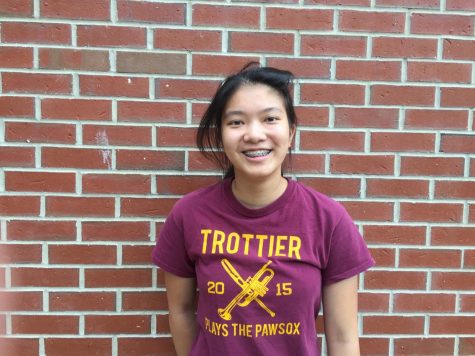Team 1100 participates in Battlecry, places 17th of 60
Sophomore Tejas Maraliga (left) and AMSA junior David Gigliotti (right) are make last minute fixes to the robot before one of their elimination matches.
May 30, 2018
Maneuvering swiftly around the playing field, Algonquin’s robotics team, Team 1100’s robot deposited cubes smoothly onto a switch and a scale.
The team’s robot, “Bowser”, nicknamed after the retro video game character, drove them to 17th place out of 60 at the Battlecry competition on May 19-20 in Worcester.
Battlecry is an off-season event that is played similarly to competition season events, with qualifications and elimination matches. During qualifications, two randomly assigned alliances of three teams compete to earn ranking points to increase the likelihood of getting chosen to work in a preferable alliance during the final rounds. Qualification matches consist of a 15 second autonomous period where the robots operate by themselves and a 2 minute 15 second period where the teams control the robots.
Ranking points are earned by scoring points in a match by controlling the switch and the scale, putting power cubes in the exchange and climbing. The 20 teams with the highest amount of ranking points get to choose two teams each for their alliances, and the top eight alliances after more matches in these alliances move on to eliminations.
According to one of the lead mentors of Team 1100, Bob Galgano, the team does not prepare as much for Battlecry as the regular season events; they mostly just make sure that they have enough equipment in the pits to fix the robot between matches. Other than that, because Battlecry is off-season, they are able to focus less on winning and more on experimenting with different people in different positions.
“The main thing is to have other people drive the robot,” Galgano said.
According to AMSA junior David Gigliotti, who works on the drive team for Team 1100, Battlecry allows people who do not usually work with the robot to use it and become more interested in it because of this hands-on experience.
“We can actually try new drivers and new operators so that next year we can get experience for students on the team that maybe don’t get a chance to drive during the regular season,” Gigliotti said. “During the season, there’s only one drive team, so a lot of people, they get to see the robot, but they don’t actually get to use it.”
According to Galgano, the team uses the observations from Battlecry to help determine who is going to be on the drive team next year.
“This is how we get a chance to see who can make the moves with the robot and is interested [in driving the robot next year],” Galgano said.
Galgano believes that although the team did well at stacking the cubes during matches with less experienced operators, they needed to improve on ensuring the robot moved quickly and deliberately.
“[They could improve on] being a little smoother,” Galgano said. “These are our new drivers and operators, so with experience they’ll get better.”
Sophomore Nadia Wong likes the lower stress environment of Battlecry because it makes the event more casual and the positions more adaptable. Usually working on the mechanics of the robot, in some of Saturday’s matches Wong worked as the human player, the team member who interacts with the field during the match to handle game cubes that need to put on or taken off the field.
“I’m given a chance to work in a position that…I’m usually not allowed to do in a regular season,” Wong said. “I think it’s good, especially for younger, newer members. It gives them a feel of working where normally more experienced team members work.”










